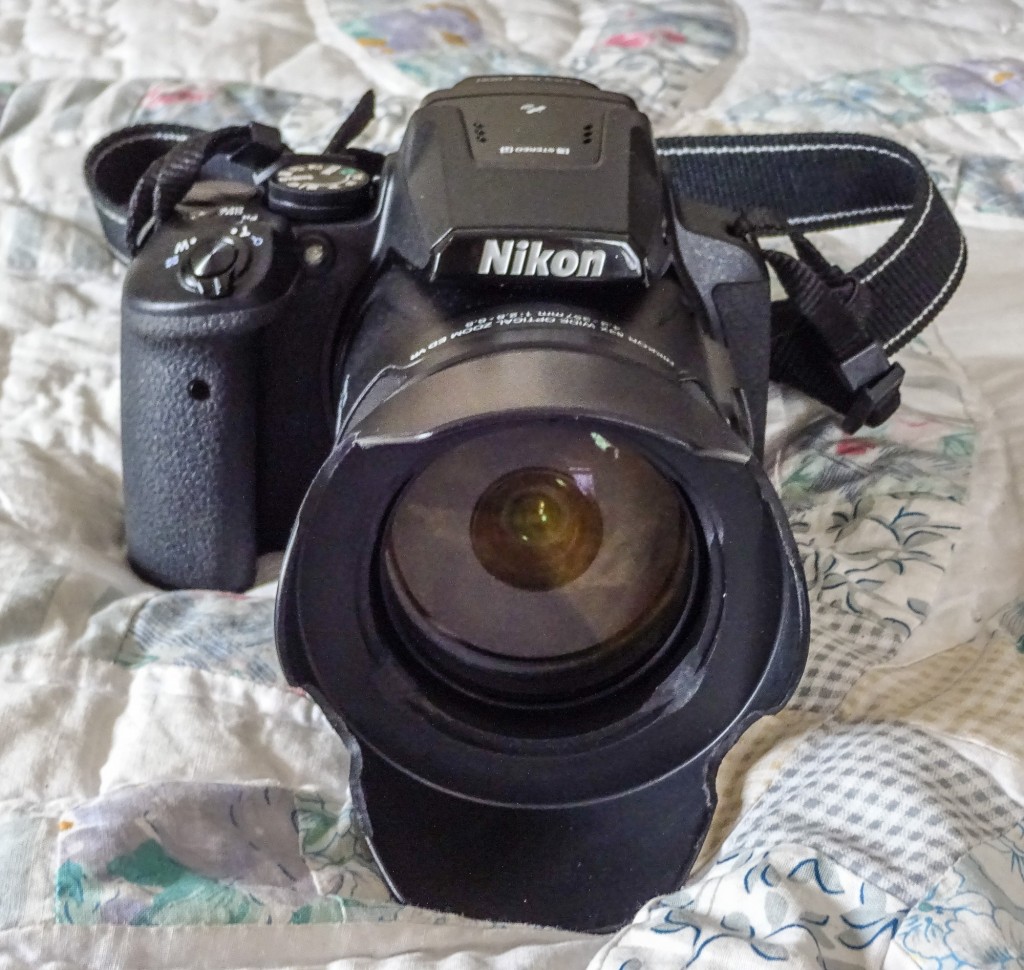
For several months the Nikon P900 was rumored around the internet. The optimistic claimed a 83x zoom! A Superzoom to top all superzooms! From Nikon.
A lot of digital ink went into poopooing the rumor. Something between “Fat chance!” and “Dream on!” seemed to be the consensus. I will admit, I was not a believer either…especially not after Nikon announced the P610 for delivery in early March….a significant upgrade to the P600, with improved focus speed and reliability, improved buffer clearing times for continuous shooting, and, by all reports, at least slightly improved image quality…and that on top of IQ that was already rated “best in class” for 16mp superzooms by many. I put one on pre-order the day it was announced!
And then, only a few weeks later, before, in fact, the P610 was readily available at retail, Nikon officially announced the P900 for delivery in late March. What? Unbelievable!
And, yes indeed, the zoom reached 83x…and the new camera included all the focus and buffer improvements of the P610. As you might expect, given the huge zoom, it is a big camera…twice the size and weight of the P610. Still, 2000mm equivalent field of view…and perhaps decent digital enhancement out to 4000mm for truly desperate situations. I debated less than a day before canceling my P610 order and preordering the P900.
Before the first units were in the hands of users, eager photographers had filled two P900 threads on the Nikon Coolpix forum at dpreview. That is over 300 posts. And that was before anyone outside the industry insiders had actually seen the camera. And those were not the only threads going either. In fact, the P900 was also under discussion on the Canon Powershot forum and several others. I think it safe to say that no superzoom (with the possible exception of the Canon SX60HS, the replacement for the wildly popular SX50HS) has generated as much interest before it shipped.
And once the first units reached customers, it became apparent from early posts on the forums that, unlike the SX60HS, for most people, the P900 was not going to be a disappointment! There were a few nay-sayers, but they were mostly people who had unrealistic expectations of a Point and Shoot superzoom, and did not give the camera a fair chance, or a few who clearly got defective early production units. (Those with defective cameras were able to trade in for new units, and in every case the problem was solved.)
My P900 came direct from Nikon a few days after the first units were in the hands of eager dpreview forum members, and I was out in the yard the next morning testing it against the Canon SX50HS and the Sony HX400V. We are still experiencing the dregs of winter in Maine, with snow on the ground, and not much color showing, so I had ordered some artificial parrots (made of dyed chicken feathers) specifically for testing. Between shots of my artificial parrot tree and the brick work on the chimney, I was pretty well convinced by the end of the morning that Nikon had done the big zoom right. And as I continue to experience the camera in my daily trips afield, I have come to appreciate what a marvel it really is.
Image Quality:
For most photographers, no matter how long the zoom, overall image quality comes first. We all know that the small sensors in our P&S superzooms will never equal the performance of an APS-C or full sized sensor, but we want something that comes close…close enough to produce satisfying images when viewed as large as we are likely to ever view them…and that will make the occasional print up to 13×17 or so. That means a sensor and image processor that produce images with good detail, as little noise as possible, and few if any “digital artifacts.” We want an image that looks like a real photograph, and not like a water-color painting. We expect some water-color effect…smearing of fine details and blotching of smooth color patches…when the image is viewed at 100% or greater…that comes with the tiny sensor…but it can not be obtrusive or obvious. And any defects should be invisible at normal viewing and printing sizes. Like I say…a photograph not a painting.
In my tests the image quality of the P900 did not really break any new ground, but it was easily as good as, and maybe slightly better than, the 12 mp Canon SX50HS…which is still, even after the introduction of the SX60HS, widely perceived to provide the best image quality of any superzoom. There is a little more noise in empty backgrounds, but also slightly more detail in detailed areas of the image. The P900 also easily matched and slightly surpassed the image quality of the Sony HX400V, which has been my go to camera for more than a year, showing less digital artifacts, equal or better detail, and about the same level of noise. And this is true throughout the ISO range, from 100-1600 where I did my testing.
Test shots are from the same distance at the same zoom setting, 1200mm…the Nikon and Sony images are resized from 16mp and 20mp scale to match the scale of the 12mp Canon. You can click on any image to open at at full size in your browser.
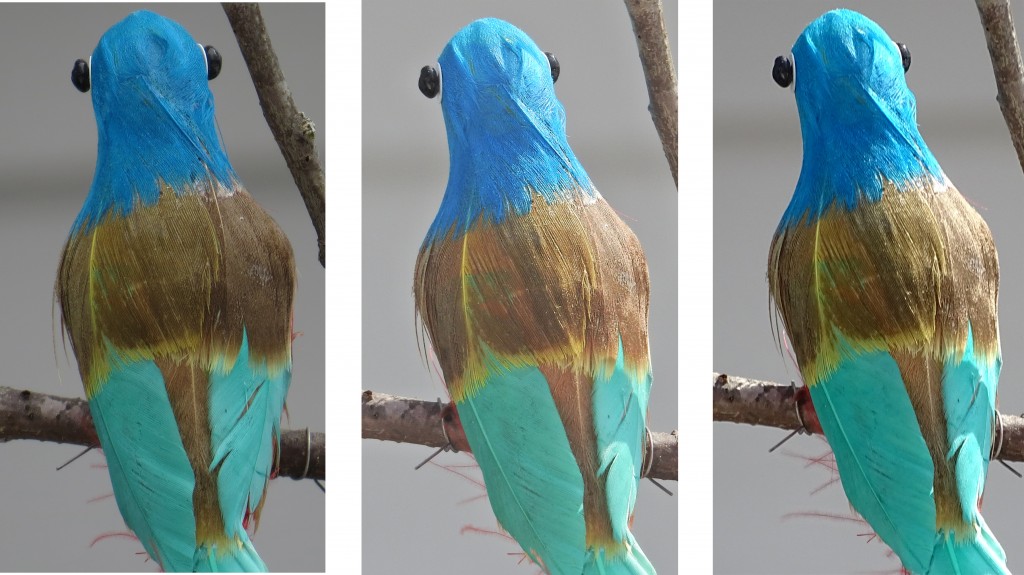
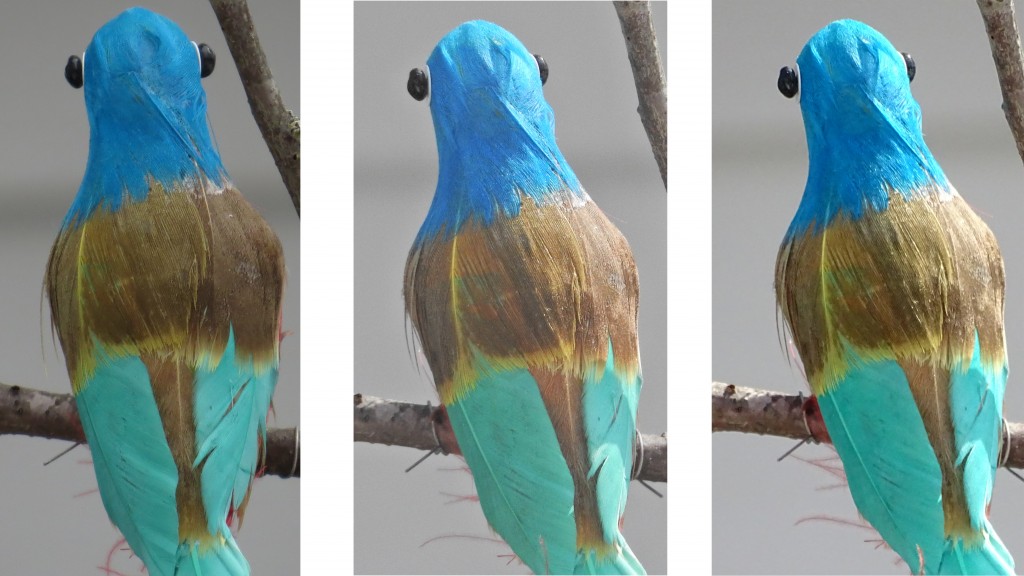
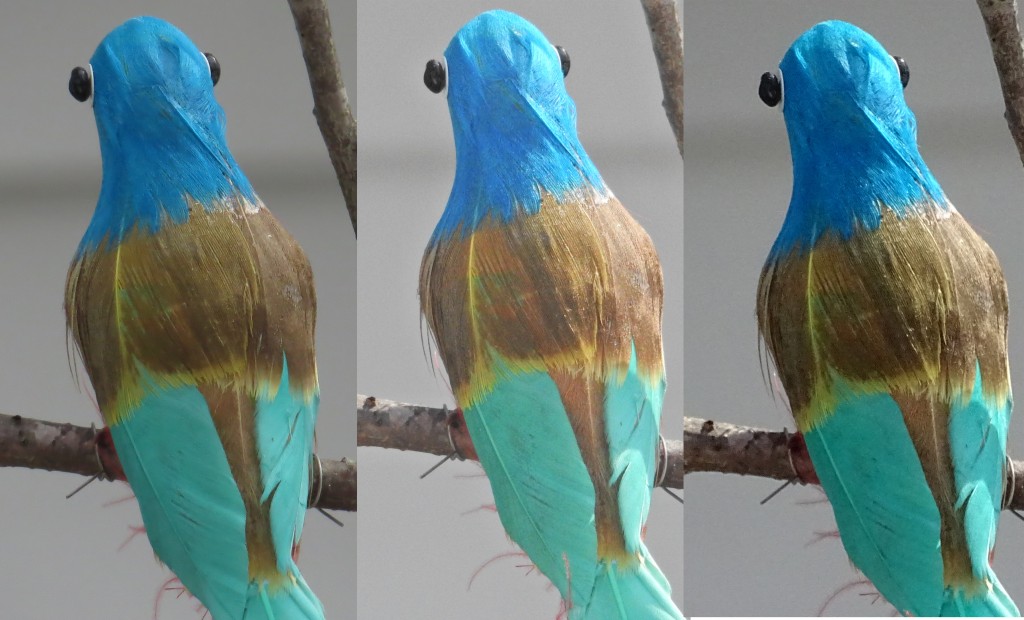
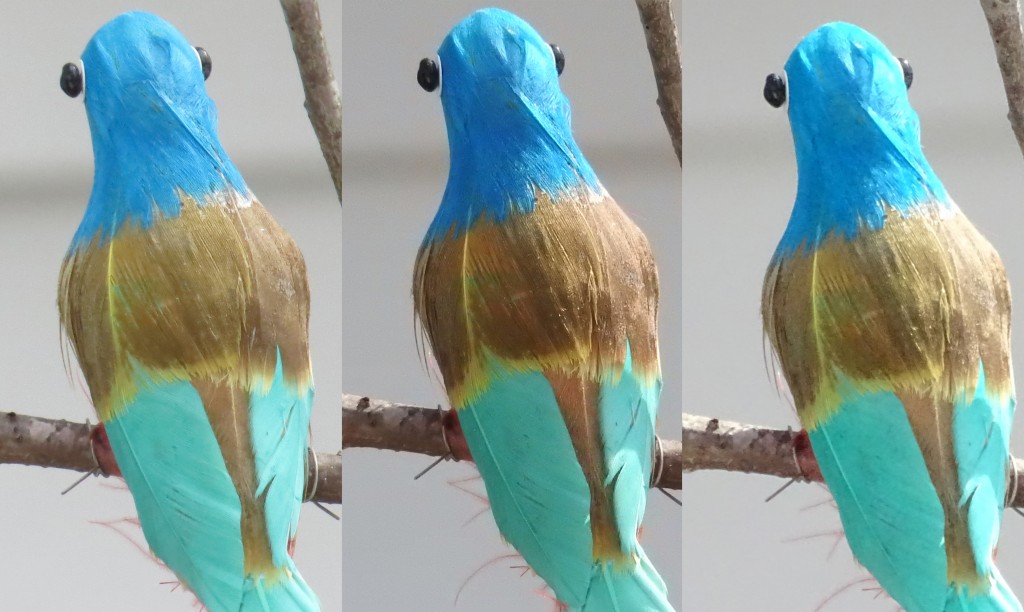
Of course Image Quality is more than the pixel level performance of the sensor and processor. You also have to consider overall color representation, balance (or fidelity), and clarity (or vividness), as well as the balance of light and dark tones (dynamic range). To be honest, I have not liked the way Nikon has reproduced color and tones in the past. To me Nikon Point and Shoot images were always “flat” and “poster-like” with colors that were just a bit off. That was one of my major concerns in preordering the P900, but I was somewhat reassured by the sample images being posted by Nikon and early adopters.
I have written about the apparent aesthetic differences in the way different camera companies choose to “render” the digital image, and that is also apparent in comparing the images from the Nikon P900, Canon SX50HS, and Sony HX400V. Straight out of camera (sooc), the Nikon images look a little “thin” compared to the Canon or Sony. Partially this is due to the fact that even at the same settings in the same light the Nikon images are always lighter overall than the other two. Either, to be charitable, the Nikon sensor is simply more efficient (requires less light for an equivalent exposure), or Nikon has mis-calibrated the ISO settings on the P900. I choose to be charitable…especially since in a long zoom camera, lower ISOs and higher shutter speeds are always welcome!
Partially because of the difference in brightness, though, the colors in the sooc images from the Canon and Sony look richer, and more saturated. Even when the Nikon images are adjusted for brightness, in direct comparison some may still prefer the colors in the Canon images. However, in actual use in the field, under a wide variety of conditions, I find the Nikon colors to be relatively accurate, and quite pleasing, once the images have gone through my standard post processing work flow.
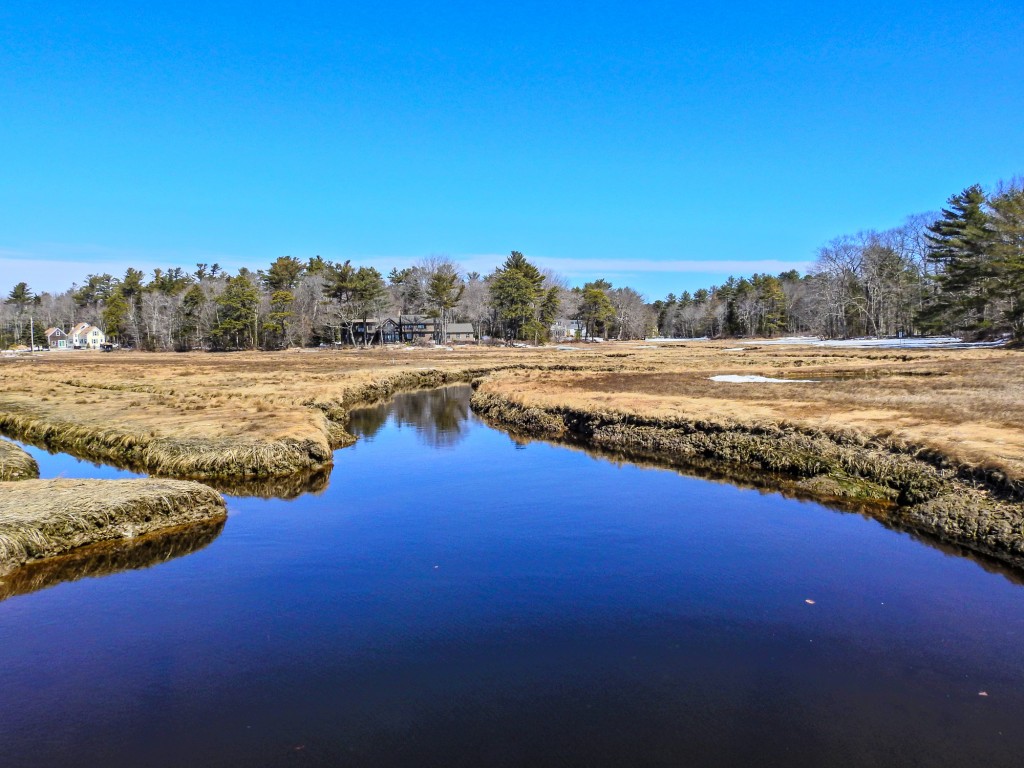
The difference between the Nikon and Sony is harder to pin down, since there I am convinced there are real aesthetic differences in how the two companies render images. The Sony sooc images are more impressive at screen resolution, with vivid colors, great tonal range, and lots of apparent detail…and they require less work in PP to bring them to a finished state…however, if you look at them at 100% they are much more painting-like than the Nikon images. The Nikon images can be punched up in PP to show the same vivid and full toned effect as the Sony, but maintain more “real” detail at larger sizes. They are more photo like…with “grain” instead of digital artifacts.
In general any doubts I might have had about Nikon color have put the rest but actual use in the field. I would rate it the equal of the Canon SX50HS or Sony HX400V…different but equal. 🙂
Lens Quality
Clearly the stand out feature of the P900 is the huge zoom…83x…a leap and bound beyond its closest rival, the Canon SX60HS with 65x (though the Canon only reaches 1365mm since it starts at 21mm.) The next longest zooms, including the Nikon P610, are 60x, 24mm – 1440mm equivalent field of view. The P900 stretches from 24mm to 2000mm. That is a significant advance.

Well and good, but more zoom is only useful if the lens is sharp, with sufficient contrast, and relatively free of distortions…and that is a tall order for such an extreme zoom range. Yet, the lens and software designers at Nikon have managed it to perfection. The lens is sharp throughout its range, from 24mm to 2000mm, and produces images with excellent contrast. I am certain if we could see the RAW files, that there is a lot of distortion and some serious chromatic aberration (color fringing) in a lens this long and this complex, but by the time the software finishes with the jpeg, all distortions and almost all color fringing has been removed. Impressive indeed.
Maximum aperture at wide angle is f2.8, quite bright by superzoom standards, and it manages to hold to f6.5 at the long end. Though f6.5 might not sound impressive, this is actually, all things being relative, one of the brightest zooms on any superzoom…and certainly the brightest long range zoom ever made. Not bad at all.
This is not just a long zoom, it is an excellent long zoom, an excellent lens period…one of the best lenses I have ever used. Amazing!

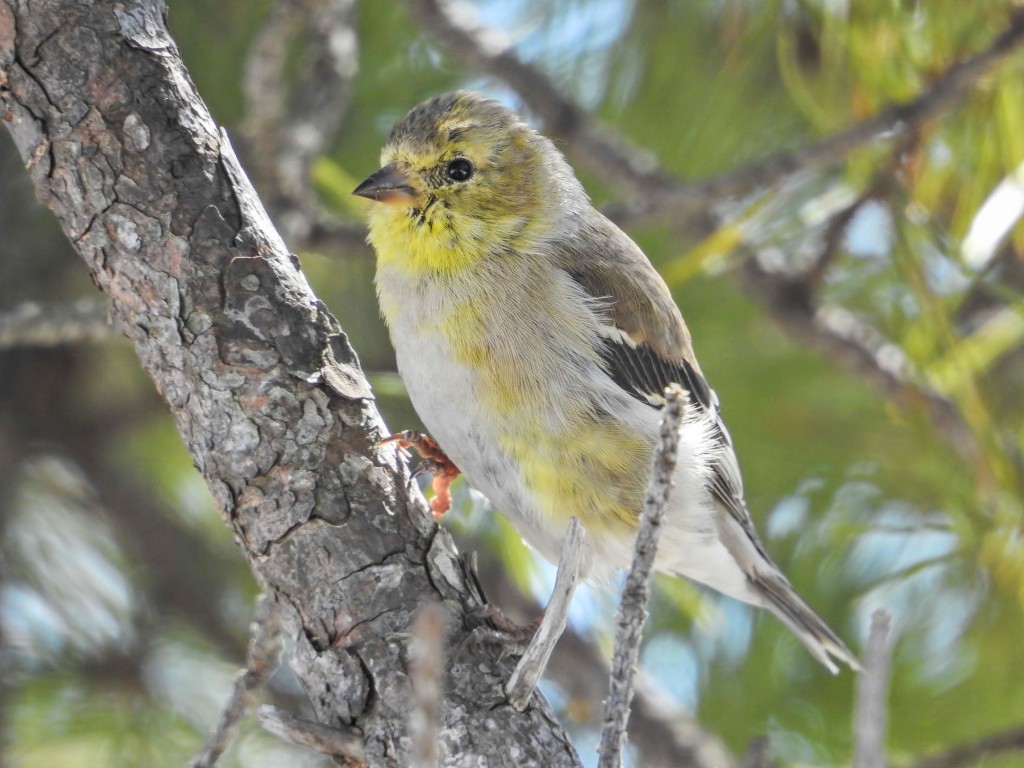
Image Stabilization.
Superzoom cameras would not be nearly so popular (or so much fun) if they did not have image stabilized lenses. Being able to work a long telephoto shot without a tripod is essential, in my opinion, to the superzoom experience. Nikon calls Image Stabilization, “Vibration Reduction” and with the P610 and P900 claims a new system that provides a 5 stop advantage. You don’t have to understand camera stops to understand that 5 stops is a lot…and in practice, the VR on the Nikon P900 is simply the best I have ever used. It is completely possible…indeed, it is easy…to hand hold shots at 2000mm and 1/500th of a second. (see images above). I have gotten good results down to 1/125. That is simply amazing. Of course, I have had a lot of practice hand holding superzooms…but, honestly, the Nikon P900’s VR performs above and beyond expectations.
And, for reasons I can not quite fathom, the view on the LCD and in the EVF during framing is among the most stable I have ever seen, even at 2000mm equivalent. There is none of the distracting (not to say debilitating) jitter you see at high power in the viewfinders of the Canon SX50HS for instance. This extra stability and ease of framing makes an excellent lens a joy to use!
One difficulty I had in testing was that the Nikon, as mentioned above, consistently used higher shutter speeds at any given ISO than the Canon or Sony (and even so the Nikon images were the lightest of the three). That meant that the Canon and Sony image stabilization was more severely challenged than the VR on the Nikon. I had to shoot a lot more frames to get a critically sharp image with the Canon than the Sony, and more frames with the Sony than the Nikon. In fact the Nikon gave me a sharp image the first time, every time. Since I am able to easily hand hold the Nikon at 2000mm equivalent, and even 4000mm equivalent with digital enhancement (what Nikon calls Dynamic Fine Zoom) I am convinced that Nikon’s claimed 5 stop Vibration Reduction system actually works.
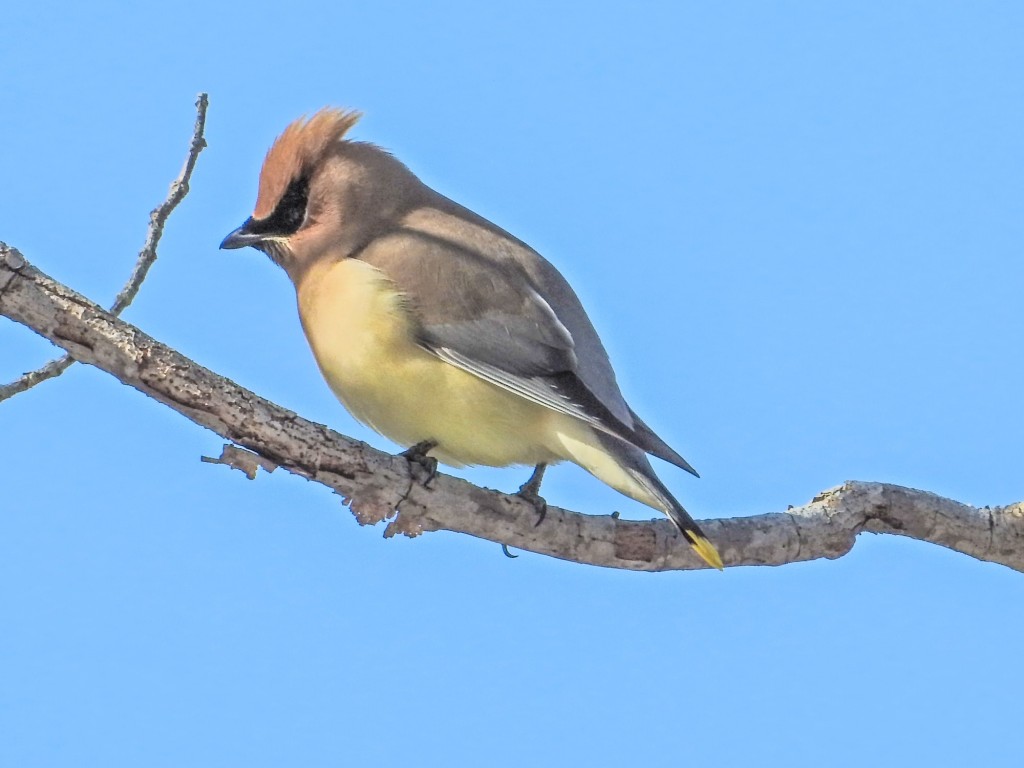
Focus speed and reliability.
One of the often mentioned weaknesses of the Nikon P600 was its slow and unreliable focus. Even in good light the P600 often had to “hunt” for correct focus, and in poor light it sometimes could not find it. Not so the P900. The P900 has, hands down, the fastest and most reliable focus of any superzoom I have used to date. It is as fast and more reliable than the focus on my Olympus 4/3s mirrorless camera. Where the Canon SX50HS and Sony HX400V were hunting and sometimes failing to find focus, the P900 snapped to focus all but instantly on the first press every time. Again, this is an impressive achievement on the part of Nikon.
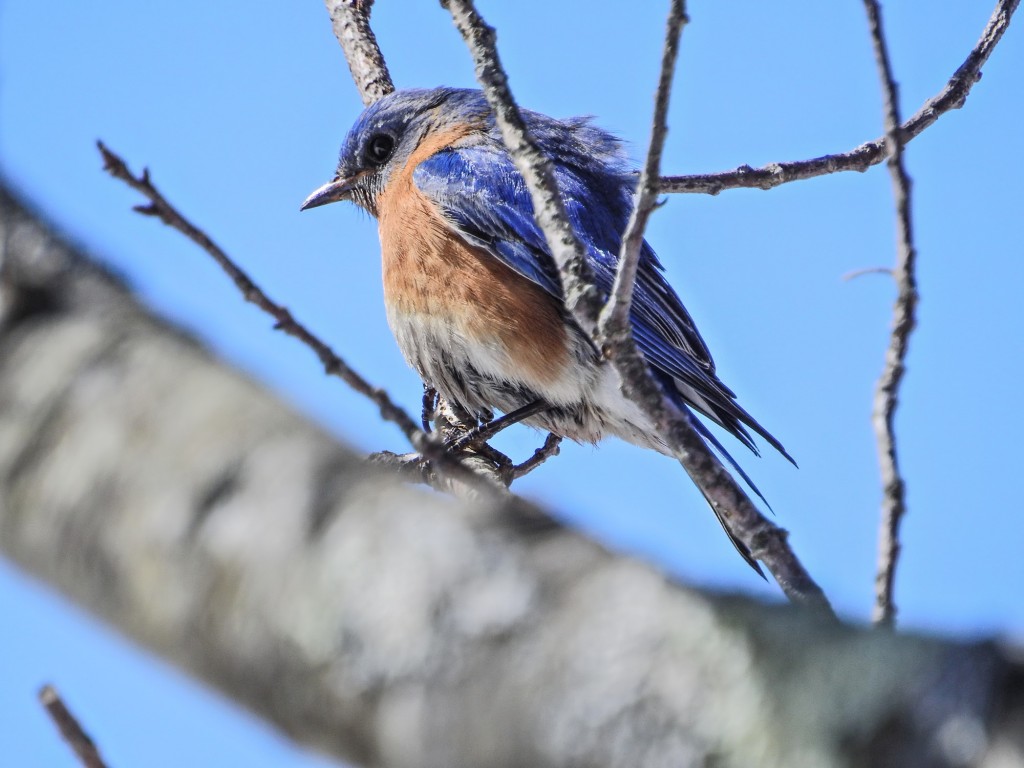
And, again for reasons I can only guess at, the auto focus is very discriminating. You can control the focus area, from 9 area Target Finding Auto Focus(where the cam era tries to locate the most likely subject in the frame), down to a very small square that you can move around the frame manually with the control wheel on the back. I have been using the “normal” manual focus square, and time and again it has found focus on birds mostly hidden in small branches, and even hidden behind foreground twigs. Perhaps some of the “Target finding” magic is at work even in manual square auto mode, but whatever is going on, it is magic! It is sometimes necessary to let the camera know the approximate distance to your subject by focusing on something in clear view (a branch, a leaf, etc.) at the same distance…but once you do, the camera will find the bird deep in the bush and focus on it, and not the branches around or in front of it. Did I say it was magic? I will say that it is so much fun…and that I am getting shots I could only dream of without resorting to manual focus in the past. And the P900 does have manual focus and focus peaking (a white outline on in-focus objects), controlled by the thumb wheel on the back of the camera, or the zoom lever on the lens, for those times when you really do need it…it is just that with the precision and apparent intelligence of the auto focus, I am not sure most folks will ever need it.

Continuous shooting
I am into birds and wildlife, and I suspect most people who are interested in the P900 will be as well. The long zoom is the attraction. However, when shooting moving (which is to say, living 🙂 birds and wildlife, a good continuous mode is essential for catching live action and for insuring at least one sharp shot out of the sequence.
The second most common complaint about the P600 was how slow the buffer cleared after a continuous burst. The 7 frames per second for 7 frames, or 2 frames per second for 60 frames, continuous rates were fine, but it took up to 30 seconds for the buffer to clear after a burst of 7 shots. That is 30 seconds when the camera is locked up…you could not even frame your next shot. This alone was enough for me to drop the P600 from consideration as a serious P&S nature camera, despite its other fine features and reported excellent image quality.
Buffer clearing is also one of my only disappointments in the Sony HX400V. It too is locked up for many seconds after a burst.
With the P900, Nikon has at leased addressed the problem, if not solved it. The P900 has the same 7 fps and 2 fps, High and Low speed, continuous modes, but on High the buffer clears in about 7-9 seconds (depending on the amount of processing you have set the camera to do on each image) after a 7 shot burst. In Low speed continuous, it can take about one second per shot to clear the buffer, but you can begin to frame your next shot before the buffer is cleared, since instead of blacking out the view finder, as it does in High speed mode, all you have is a little animated swirl of dots to indicate “clearing in progress” in the center of the frame…and you can start your next sequence before the current one is completely cleared. In fact, with 90mbs UC-1 Class 10 SD card (IQ at Fine, Noise Reduction at Low, Picture Control at Standard, and Active D Lighting to Low) there is no buffer clearing delay at all in Low speed continuous. In both modes, during the actual burst the view stays live. In High speed, the display flickers. In Low speed, there is a very brief blackout between frames but the view comes live again to show you where you are.
I generally use the Low Speed Continuous for the faster clearing, and because 7 fps often gives me 7 identical images…2 fps is fast enough for most bird and wildlife action.
There are several other, lower resolution continuous modes for capturing really high speed action, and there is a Best Shot Sequence mode which shoots up to 10 frames and only saves the sharpest. I am still experimenting with that to see if it might be useful for birds…but with the exceptionally fine VR, I am not sure it is of much use.
(I might note here, that if continuous shooting is your thing, either the Canon SX50HS or, even better, the SX60HS, will have better continuous performance. And, second note, in my experience the P900 will benefit from the fastest SD card you want to throw at it 🙂
EVF and LCD
One of the new features of the P610 and P900 is the higher resolution Electronic View Finder. At 908k it is tied for top resolution with the SX60HS, and far superior to either the previous P600, the SX50HS, or the Sony HX400V. Like the SX60HS, it is relatively small for all its detail, so the Sony might impress as better at first glance since it is both bigger and brighter. However the higher resolution comes in handy in the field, in making it easier to pick your subject out of a confusing background. After a few days of using it on factory default, I found the menu entry to turn the brightness up (Settings:Monitor:EVF options) and that helped a lot! It is, all said and done, the easiest EVF to use that I have seen on a P&S superzoom.
The monitor itself is fully articulated, from folded in against the back either facing the camera (for protection) or facing out for viewing…to off to the side and angled for ground level or over the head shooting. It even faces forward for selfies. It too is relatively high resolution at the same 908k dot pitch. I found it easy to use in just about any light, and I really enjoy the full articulation. It is, by the way, if you are keeping score, only equaled by the Canon SX60HS (the SX50HS has the same articulation but much lower resolution), and clearly superior to the single axis articulation on the Sony.
Size and weight
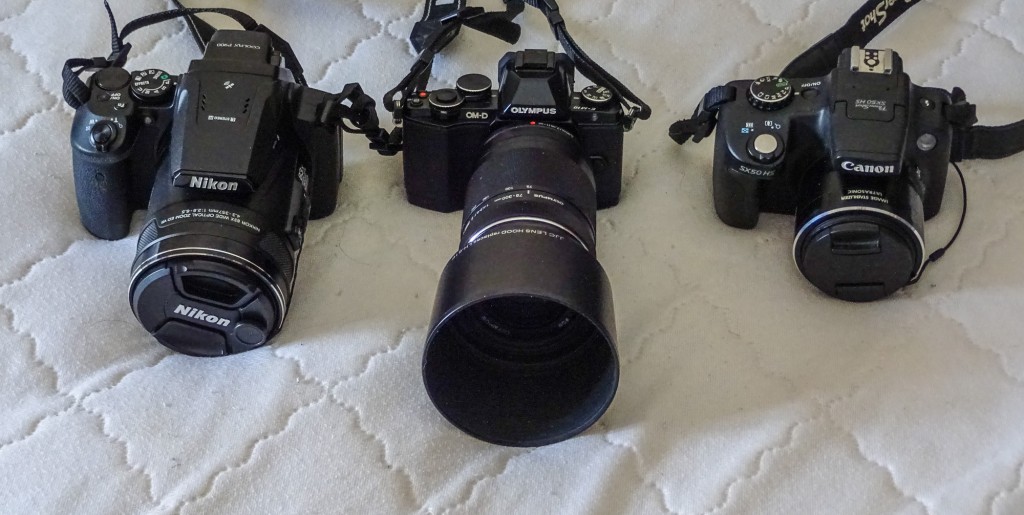
Okay, this is really the elephant in the room. 🙂 The P900 is big, and it is relatively, by superzoom standards, heavy. It is over twice the size and weight of the SX50HS, and a third again as big and heavy as the already large Sony HX400V. It is a size larger than my Olympus 4/3s body and the 70-300mm zoom. In fact I have to use the same size case for the P900 and the Oly and zoom, and the P900 is a tighter fit. It is not a compact camera. But then, it could not be. A zoom reaching 2000mm equivalent at f6.5 is going to be big. Think of it in terms of a larger sensor. This is really a 4.3 to 357mm zoom. Look at any f6.5 300-400mm zoom lens for any camera. How big is it? Yes…it is about the same size. That is just physics. The zoom on my P900 is just slightly larger than the 70-300mm f6.7 zoom for my Oly. And with a zoom that large, it makes sense to make the body larger too. Nikon could have fit the P900 body into the same space as the P610 body, but it would have looked really funny behind that big lens, and the handling would, in my opinion, have been seriously compromised. As it is, the camera over all is very well balanced and feels great in my average male hands. Even with the zoom fully extended, it still feels “right”. Nikon has provided an excellent grip around front, a raised and angled thumb pad, and textured griping areas near the end of the zoom housing on the body…all perfectly placed for my hands with the camera in shooting position. Already, after only a week of using the camera, the SX50HS, and even the Sony HX400V feel “dainty” and slightly “fussy” by comparison. This is real camera, built to feel like a real camera…and it does.
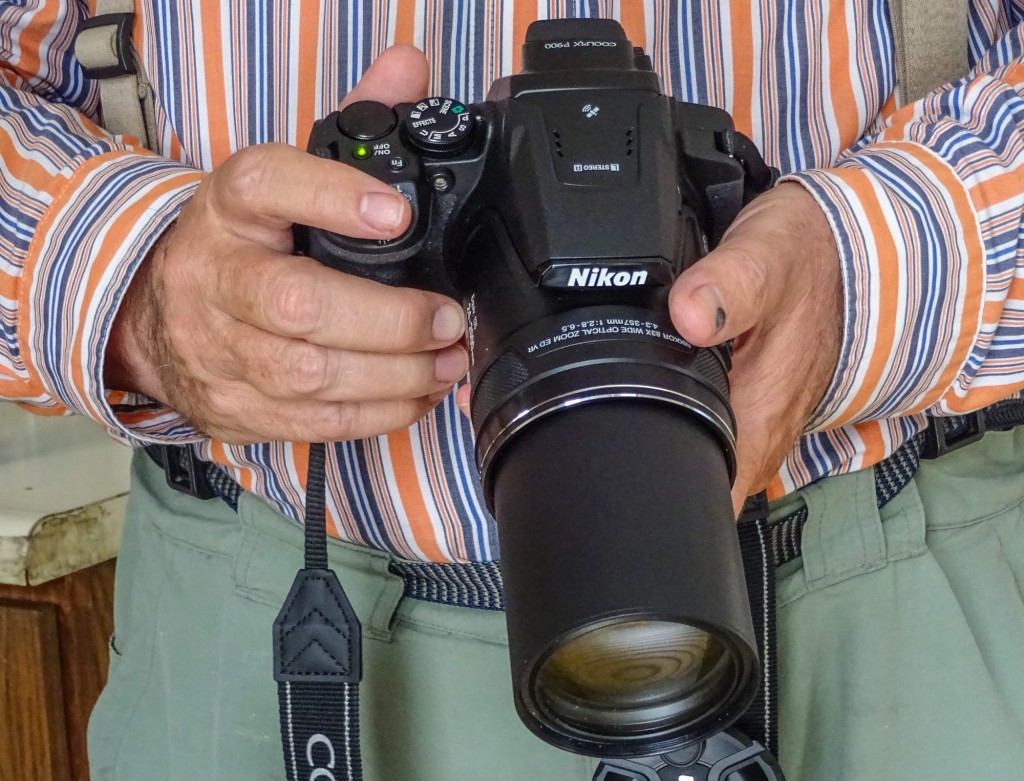
(Most of the weight of the camera is undoubtedly glass. The lens elements are so heavy that you can feel the inertia when you zoom, like hanging on to a gyroscope, especially when everything is in motion in turning the camera on or off. For a second there, the camera seems to have a mind of its own.)
I find that I can carry the P900 easily all day, without much more fatigue than a more compact solution…and, given the advantages of the long zoom, that is all I need.
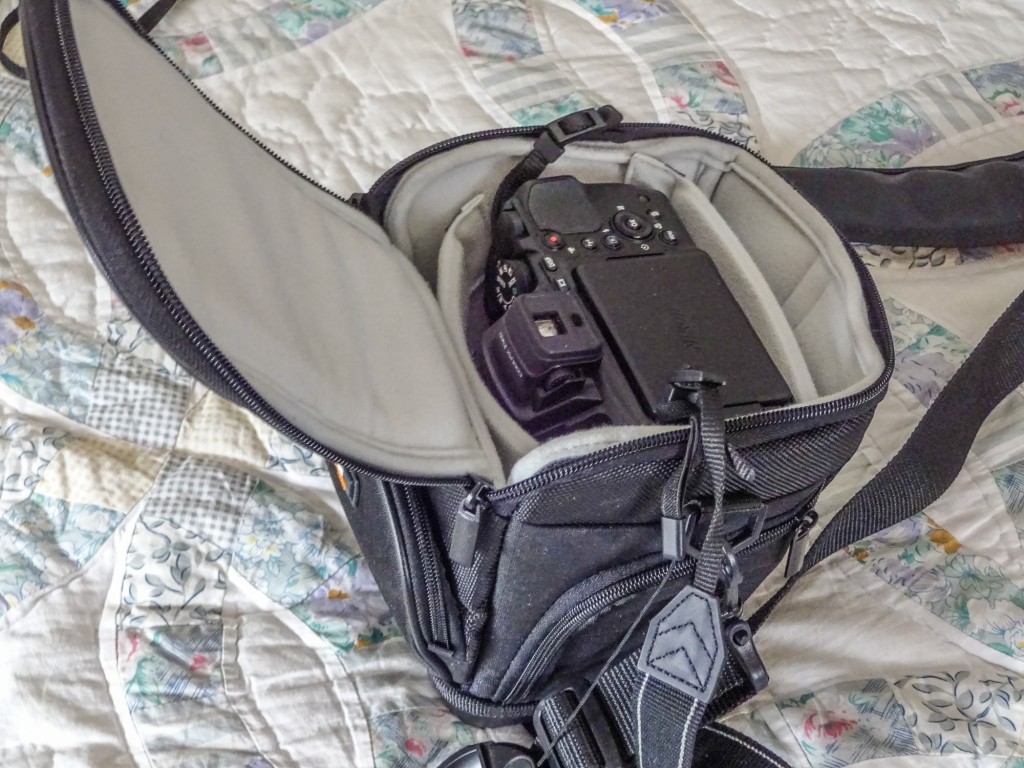
Controls and layout
The Sony HX400V has the best set of controls and best layout of any camera I have used, except for my Oly Micro 4/3s. Fortunately, the P900 is a close second. It lacks some of the control features of the Sony…it only has one User Settings memory instead of two, there are less options to control what Sony calls Creative Styles and Nikon calls Picture Controls, the HDR settings options are sparse by comparison, as are the Dynamic Range extension options, etc. And the Sony Function button brings up a full selection of the things you might want to set…at your fingertips, while the Nikon function button only really provides easy access to one function at a time (the others are available but they are hidden behind a separate Function icon…another layer deep). The Sony thumbwheel is better integrated with the control system and easier to use. (On the other hand, the Canons have no thumbwheel at all). Zoom control on the Nikon zoom housing is handy, and it can be switched to manual focus when your are using manual focus, but there is nothing as intuitive as Sony’s fly by wire lens ring for either zooming or focus. And why, Nikon, can you not set the zoom control to override auto focus in the auto modes (as you can the ring on the Sony)?
But all that is really just quibbles. If I had never seen the Sony, I would be completely satisfied with the controls and layout of the Nikon. The thumbwheel is there and works. The menu layout is rational and easy to access. The function button, if slower than the Sony, does give you pretty quick access to commonly changed functions. The only thing clearly lacking is an ISO button or the ability to set one of the other controls to ISO.
The Snap-back-zoom button (also available on the Canons…a button on the zoom housing that increases the field of view when at high zoom with a single press, so you can find your subject, and then returns the zoom to full extension when released) is a great feature, but with the high resolution and exceptionally stable EVF, I find that I am not using it as much as I might.
All in all Nikon as provided the P900 with a usable set of controls and an intelligent layout. What more could you ask?
Scene modes.
I carry a superzoom because of the extreme versatility it provides. For me it has to be a “does it all” camera. I retired the SX50HS for the Sony HX400V in order to get two features that I had come to value in a Samsung pocket compact that I got in between: in-camera HDR, and sweep panorama…both of which I enjoy.
In-camera HDR takes three exposures at different settings, and then combines the three into one full range composite showing a higher dynamic range than any single exposure could manage. When done right it makes for extra dramatic, though still realistic, landscapes (especially with clouds), and a sense of heightened reality in shots of buildings etc. The Sony HX400V is hard act to follow here. It has the best, most flexible, HDR modes of any camera I have ever used. You have fine control over how the final image will be composited, and it does it so well and so smoothly that there is really no reason not to use it for every landscape and much street photography. The detail recorded is a rich and as beautiful as any standard shot…only more-so. And you never needed a tripod. Hand held HDR was totally possible with the Sony.
One of my greatest disappointments in the SX60HS was just how poorly the in-camera HDR had been implemented. It was there, but, short of using a tripod, I never got it to produce acceptable results. The fine detail in the images it produced was always completely smeared, and the colors were always off. Not pretty.
The Nikon is somewhere between the two. In-camera HDR is buried in the Scene Modes under Backlighting, where it is one of two options (the other is using fill flash.) You have no control over how the composite is produced, and there is (again, short of using a tripod and turning VR off) always, to my eye, a slight decrease in fine detail due to the way the three images are stacked. On the other hand, it makes really nice skies with clouds! They require some extra processing due to the added noise introduced in combining the three images (something Sony evidently processed out before writing the image to card), but the cloud effects can be very impressive. So, in-camera HDR: not great but usable.
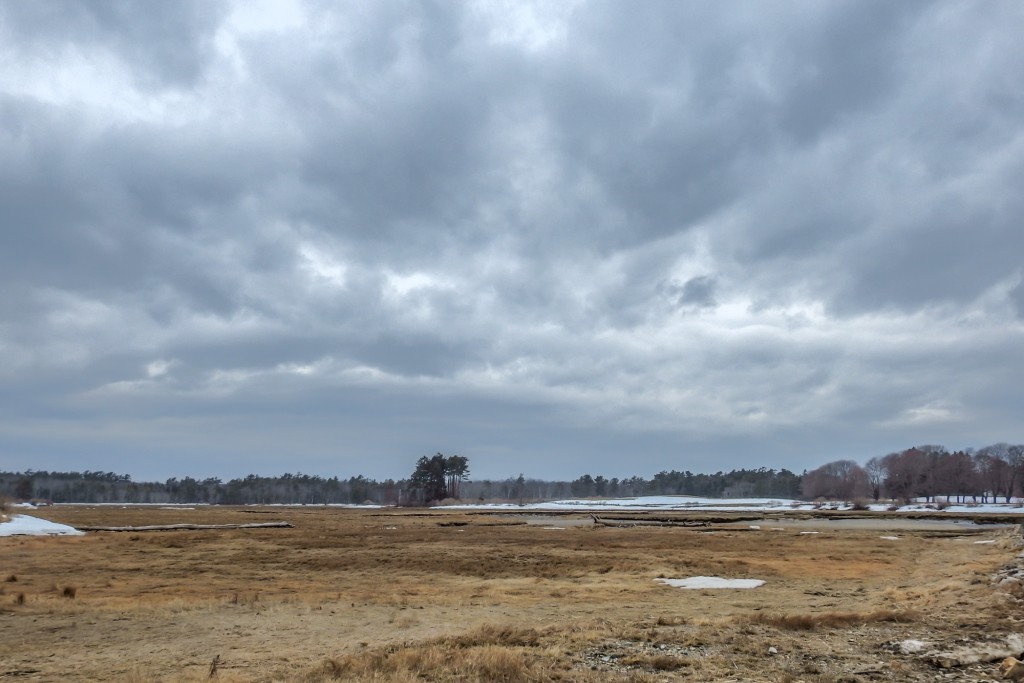
Sweep Panorama, on the other hand, in the few I have had a chance to try, seems to work quite well. Sweep panorama is when you press the shutter release and sweep the camera around in an arc in front of you, 120 degrees,180, 360, etc. while the camera records the scene one sliver at a time and writes the whole sweep to the card as a single image. It is much soother and organic than the kind of panorama where you take overlapping images and try to assemble them in software afterward. On the other hand, it does not produce as high resolution images. Still, for use on the web, or casual printing of the wide and wonderful sweep of the landscape, they are fine: 4800 x 960 for 180 degrees, or 9600 x 960 for 360 degrees.

Sports mode generally makes focusing on moving subject easier and sets the camera for burst to catch action. On the Canons and Sony, it worked well, very well, for birds in flight…one of the trickiest subjects the Point and Shoot Nature Photographer can attempt. While I did not try the Canon SX50HS, the Sony also worked really well for particularly active birds…like feeding Reddish Egrets…keeping the bird in focus and facilitating a burst at the critical moment. My limited experiments with the P900 are promising. I need to get somewhere with a lot of bifs, but I think it is going to work fine.
The Close-Up scene mode seems to work well for macro. It presets the lens to macro range, and it might do some extra processing on the background for separation of subject (I am not certain yet, and Nikon is not saying). Macro, either selected by the Close Up mode, or manually using the control wheel on the back of the camera, works within a zone at the short end of the zoom, focusing from 0 cm at full wide, out to about 3 cm at 100mm equivalent. Excellent! Close up mode also gives you a second exposure option, where the camera takes three images at a fast shutter speed, and stacks them for the correct exposure…to eliminate noise.

Landscape Mode, while still technically a scene mode, has a dedicated icon on the control dial, right along with Auto, Program, Scene, etc. It is a one turn set. There are two options available via the Menu button: Normal single shot, and Noise Reduction burst. Both options set exposure, Active-D Lighting, contrast, sharpening, and saturation to what the Nikon engineers deem is most pleasing for a landscape shot. Single shot is what it sounds like: press the shutter and click. NR Burst takes three images at low ISO and “sums” them to achieve the correct exposure, which should, in theory produce a resulting image with lower noise. In my testing, it appears that there is a light level threshold before NR kicks in, even when you have it set. In normal daylight you still get a single shot. In lower light, near dawn or dusk, you get the NR burst.
The good news is that the Nikon engineers and I apparently agree on what a landscape ought to look like. The rendering is rich and vibrant, with lots of detail (without being over-sharpened). It is particularly effective for landscape with clouds and the cloud rendering is almost as good as the built in HDR. In fact, once a bit of PP is applied, Landscape mode images look a lot like the images produced by the built in HDR, only they have a lot more fine detail! This is good. I like it. I will use it!
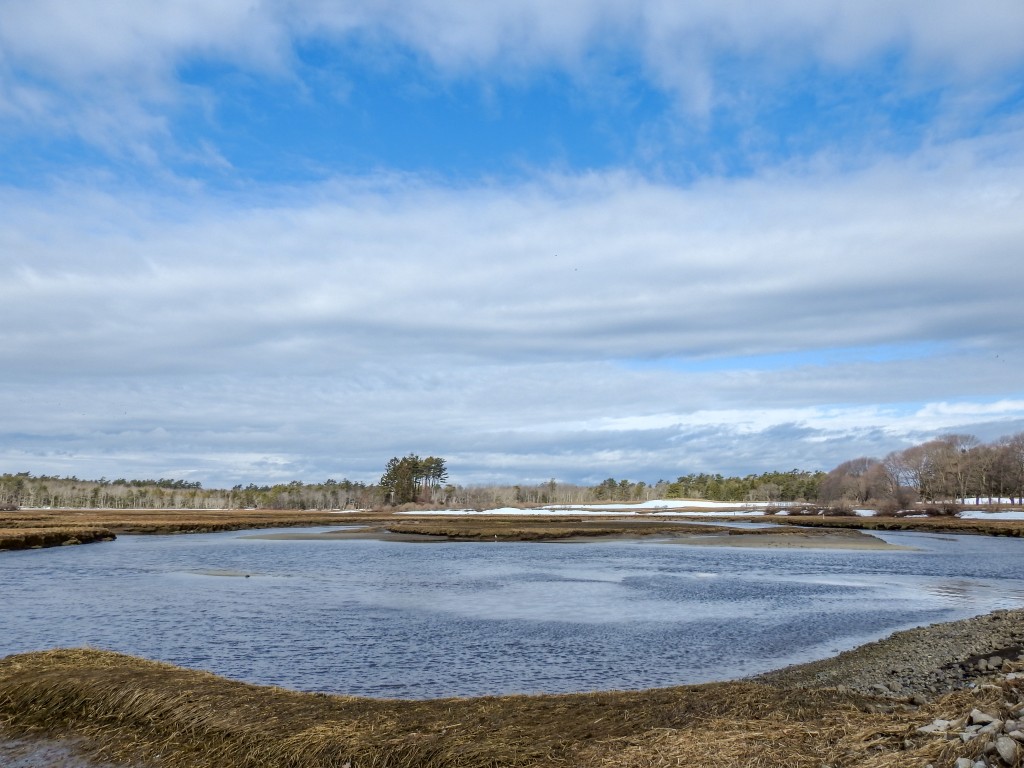
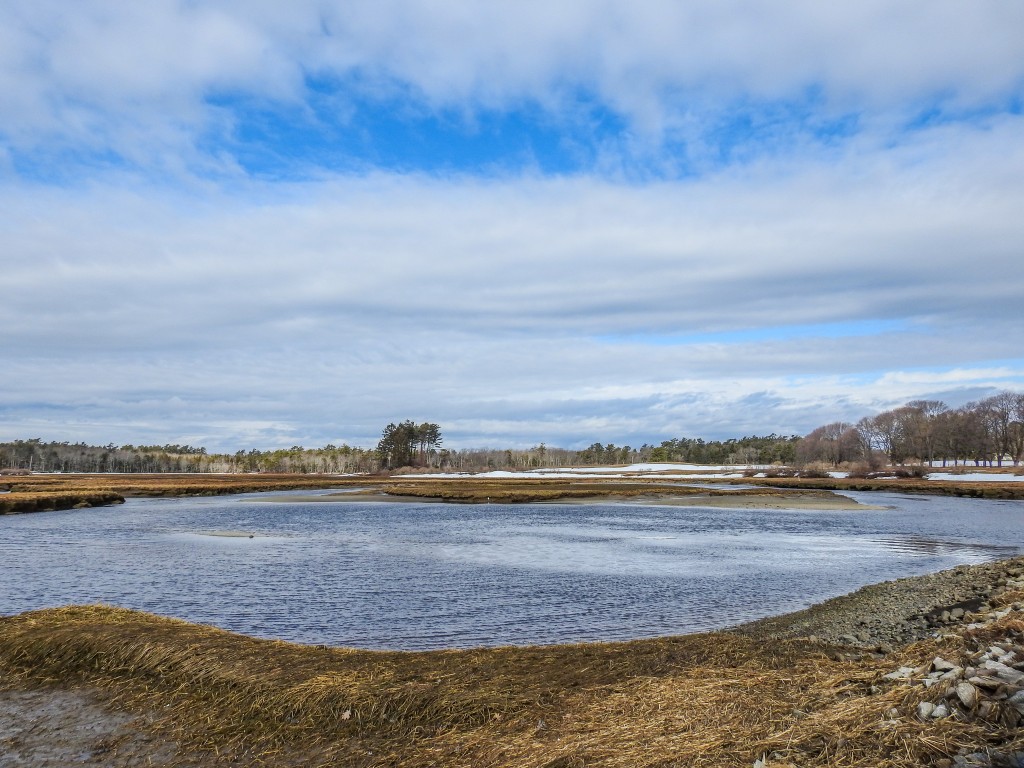
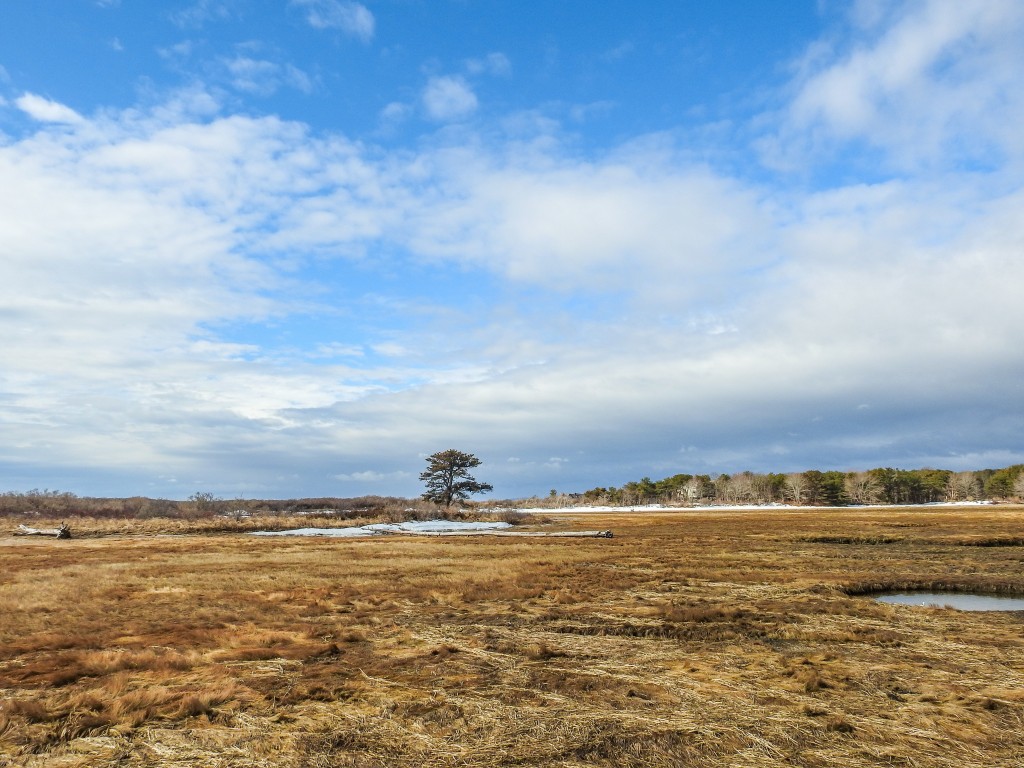
I have not yet tried most of the the other scene modes. I will get back to you at least on Hand-held Night Scene.
There is a Birdwatching Mode (clearly Nikon recognizes that one of their major customer groups are birders). Unfortunately it seems pretty much useless. In theory, it starts with a wide view to find the bird, then with a press of the OK button, zooms into 800mm equivalent and takes a burst of pics. That is were it breaks down. I can find no way of returning the zoom to the wide position without zooming it back manually. That I can do myself thank you, without any scene mode. And I am not sure why anyone would use this setting instead of the snap-back zoom button which is there all the time and gives you the option of the full 2000mm reach ????
Drawbacks and disappointments.
Biggest: close focus at the 2000mm end is only 16.5 feet, and that is far…maybe not for most birds and wildlife, but it is very far for bugs! Average working distance for dragonflies and butterflies is in the 6 foot range. That is where the SX50HS shines, focusing to 4.5 feet at 1200mm gives you amazing close-ups of dragons and butterflies in the field. I will have to experiment with readjusting my expectations and shooting from further away, but already I am missing the close focus. I may have to resort to carrying the SX50HS on bug specific outings…that or buy a P610 (6 feet at 1440mm). We shall see.
And then, as I mentioned, HDR could be better implemented. I will also miss the “Anti-Motion Blur” mode from the Sony…which I used for indoor shots quite a bit. The previously mentioned lack of a dedicated ISO button is a drag, as is the missing option to reprogram any of the existing buttons. Oh, and wifi is poorly implemented…it only really works with the Nikon app on Android and iOS devices. There is, as far as I can see, no way to transfer images via wifi from the camera direct to your laptop. And, from what I hear, the Android and iOS apps are pretty basic. I mean, why bother with wifi at all if you are not going to do it right?
The tripod screw socket is way off to one side, making it unnecessarily difficult to balance the camera on the head of the tripod. Why?
Some will complain about the lack of RAW shooting, but I am not one of them. I have yet to see the advantage of RAW for the work I do. And the same goes for a hotshoe. I don’t use external flash and would not carry it the field. No loss.
And that is really about it. Not a long list at all, considering.
Conclusion.
There is very little that Nikon did not get right in this very ambitious attempt to blaze new ground in the superzoom market. Longest zoom, and a great zoom to boot. Excellent Image Quality overall from a more than averagely efficient sensor and an excellent jpeg image processing engine. The best image stabilization of any superzoom to date, making hand holding this huge lens totally possible. Fast, reliable focus (the fastest and most reliable I have experienced, with a bit of magic built in that makes focusing through foreground twigs and leaves possible). Excellent EVF and fully articulated LCD monitor. Decent continuous mode. Excellent macro mode. Usable in-camera HDR. Excellent Easy Panorama mode. And balance and handling layout that make using this admittedly big superzoom a joy in the field.
Can you tell I like it?
A week from today, I leave for a week in Panama at Tranquilo Bay Resort to scout for a Point and Shoot Nature Photography trip to be scheduled for next year, and then a week in St. Augustine FL to teach Point and Shoot Nature Photography workshops at the Florida Birding and Photo Fest. By the time I come back I will have a lot more experience with the camera under my belt and perhaps will have more to say…but for now…I think Nikon did the big zoom right!
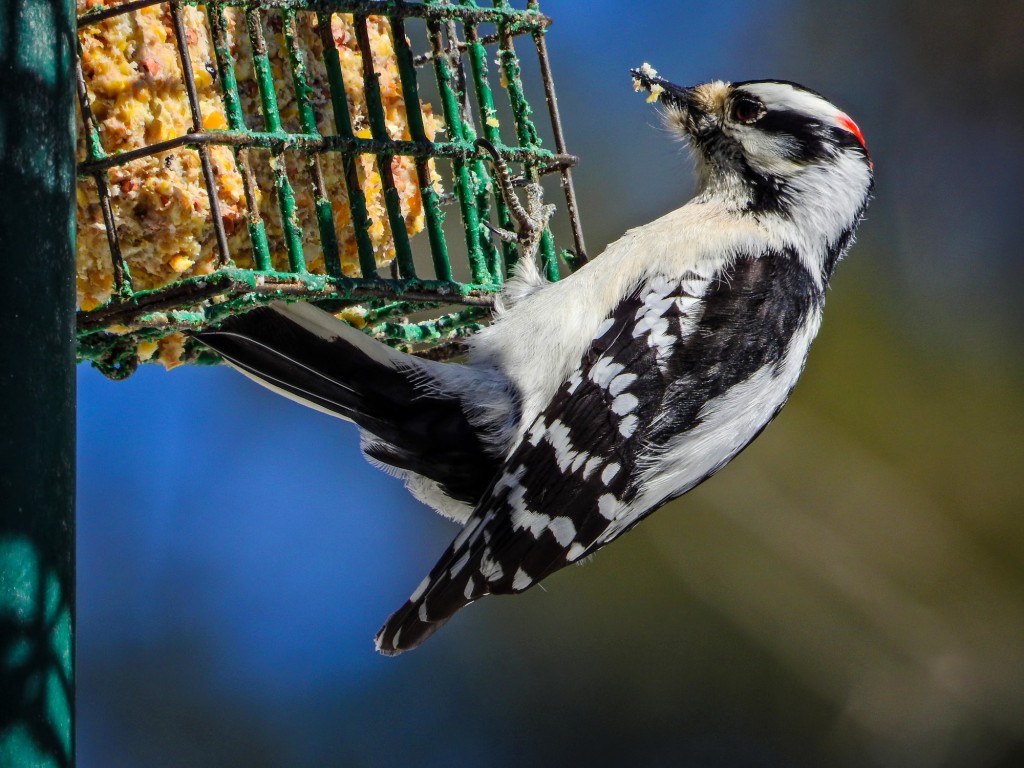
[Note! 5/12/15. Today Nikon released firmware update 1.1 for the P900 which may address some or all of the issues mentioned below. I will let you know as soon as it has a fair trial. 🙂
Be aware that a significant number of P900 owners are experiencing apparently random system crashes requiring removing the battery to reboot the camera. One user (at least) has suffered complete failure after a crash. Also, as of the middle of April, there are NO P900s available for sale from reputable dealers. A few continue to appear on ebay and from Amazon partners at inflated prices, but it appears that all official channels are out of stock. Rumor has it that it might be 5 months or more before the P900 is available again. My own P900 has frozen twice…and recovered each time after removing the battery and reinserting it. I still stand my the review. It is an amazing camera, but there might be some issues in the first production run.]
That’s an excellent review, Stephen, thank you very much! I mostly like that you analyze, in detail and extremely well, the important aspects of that camera, not taking into account secondary features not directly related to photography, like Wi-fi, GPS, how long the battery life is or others. Besides your images are extremely suggestive in backing the story.
Thus I deem your review is much better than a “professional” one, like that normally published.
Excellent review! I have already use Canon SX30, SX40, SX50 (the best) and SX60 (very frustating!). I loved to hear the Nikon P900. You’ve convinced me!
What about the video mode?
Thank you again!
Stephen, so nice to put a face with the OP I followed for years on the DPR Canon Powershot Talk forum. This is the best camera review I ever read. Everything was on point and tailored to what I wanted to know. I am very excited about the camera. I got away from my SX40, which I found to be an amazing camera (it got me back into bird photography). When I lost my backyard bird studio, I found that the SX40’s reach was not enough. I am looking forward to shooting with the P900. Thank you for your effort and your quite convincing image samples.
Thank you for a very helpful and comprehensive review.
The Nikon Coolpix P900 looks like a great camera I just wish Nikon was making them available to customers in the UK.
Launched here in March but since then almost no supplies. Amazon used to say ‘delivery 1 to 3 months’ but they’ve been saying that for months so clearly just a guess, and then last week [17th July 2015] they have change it to simply ‘Currently unavailable we don’t know when or if this item will be back in stock’ ! So I image even they got exasperated by the ‘where is my camera’ emails.
Some specialist Nikon approved camera sites are still taking pre-orders but with no idea when they will have stocks and one has now posted a red banner across the page saying that ‘Due to issues with Nikon securing stock for the UK we will not be able to supply this camera until September / October 2015’ And I have to wonder how sure they are even of that prediction as no-one seems to know what is happening with supplies. I’ve pre-ordered with a company that wants only a nominal deposit which seems fairer but none of them have any idea when Nikon will ship any cameras to fill even the pre-orders.
I know Nikon issued an apology back in May but that was 6 weeks ago surely they must have some idea what is happening and IF they are still actually manufacturing, and it has to be a big IF, then surely they should have some schedule of shipments and so be able to say when the UK Nikon dealers will be getting their share of whatever units are being made. The fact that they haven’t makes me think the reason is that, despite the predictable denials, there is some serious technical fault which they are endeavouring to rectify before shipping more units. Why else the near total lack of stock worldwide and the deafening silence re future deliveries.
A couple of days ago I had another ‘problem, what problem’ message from Nikon ‘…thank you for your comment. We understand your frustration. The Nikon Coolpix P900’s popularity has been enormous, and we are working hard to get more stock on the markets. We hope to have more news soon. Thank you for your patience, and sorry for the inconvenience.’
But as I replied ‘…popularity has nothing to do with Nikon’s inability to provide Nikon dealers in the UK with some schedule of delivery. If you are still making the camera as you claim, then some units must be being shipped, why not to the UK? The Nikon dealer I have pre-ordered through told me they haven’t seen any units since the launch and another has made it clear they have heard nothing either. Are UK dealers being penalised for some reason? If not then it is simply untenable to suggest that though you are still producing the camera, and after the apology one might have actually expected an increase in production, you still have none for the UK market and no idea when this situation will change.’
So, who knows, by the time they get it rectified and in production one of the other makers will have something even better about to launch. There is talk of a 100 x zoom Canon Powershot for 2016.
Meantime I wonder how many pre-orders will be cancelled as people become disenchanted and decide 65xzoom in the hand is better than a Nikon promise of 83x sometime never, especially if they want a camera for the Summer. Nikon may not be able to deliver yet but surely by now they should at least be able to give a realist deliver date – the only reason they don’t that I can think of is that they are still trying to rectify whatever the problem is that they don’t admit to having.
All very frustrating. Nikon are turning a publicity coup into a disaster as more and more questions about supply go unanswered and all most of us want is a little candor, we want to know when Nikon will be fulfilling pre-sales to Nikon approved dealers in the UK.
I understand your frustration…but I don’t have any answers. I hear of a few people finding one in stock in the US, but it seems to be hit and miss. Certainly Nikon did not anticipate just how many people would want an 83x zoom camera. But then it would not be the first time Nikon (or any of the camera companies) has snatched defeat from the jaws of victory 🙁
Which one would u choose between a Nikon P610 and Sony HX400 for every day camera.
It all depends on what is more important to you. The P610 has slightly more reach and marginally better image quality overall. The HX400V has more vivid images straight out of camera and better implemented multi-frame effects (in-camera HDR, hand-held night shot, multi-frame noise reduction, anti-motion blur, etc). The Sony also offers better control over the jpeg processing. Either camera will give you great results. For birds and wildlife I would go with the Nikon as having just a slight edge. If you shoot a lot of landscapes, macro, etc. then the Sony has a slight edge.
Thanks for advice
I shoot a lot at the zoo, buildings and me and my friends when we go out in the city (day and night photos), but i want also to shoot planes because i stay near an airport, also i would try some moon photos. I also edit some of my photos in lightroom.
Do you think p610 would be better for this kind of photos.
Great review of the P900, I am trying to decide whether to buy the P900 or the Panasonic FZ1000.
I mainly would be using the camera for wildlife but also other general stuff like holidays and family etc.
I like the idea of the massive zoom of the P900 and you and others have shown it is possible to get great photos from this camera, However the Panasonic has a very fast AF and faster burst mode with a even fast clearing buffer along with 4k video etc etc.
Any thoughts ?
I have not tested the FX1000, so I do not have an informed opinion. The other option is the new, and also as yet untested, Nikon B700, with 4k video.???
I have now had some experience with the FZ1000. It is a great camera, well suited for close in work and landscapes, with great image quality and a good feature set, but the 400mm limit is very restricting on birds.
Hi Steve,
I have been trying to set my camera in a good setting,nso I can take bird photos in Panama this July. However for some reasons, my continuous low setting under the P mode only shoots a single photo at a time instead of a few photos at a time. I am able to shoot under continuous low setting under Sports and Birdwatching mode, but not under P. Do you know why?
Some other settings will interfere with Continous shooting. Flash use for instance. Do you mean that you can not set the camera to Continous or that it does not take more than one shot while holding the shutter release down, even though you have it set to Continous?
Yes, i set it for continuous low under P mode but when i try to shoot a picture, it does not take more than one shot while holding the shutter release down. But I could take continuous shots under the scene mode, like sport or bird watching. Very strange!
Is the Low Continuous icon showing in the finder?
Hi Steve,
It’s working now! Thanks.
Hello Steve,
I’ve been looking for a good lens hood for the P900 and saw your post on DPReview regarding this hood: http://www.dpreview.com/forums/post/55618033 ,
although I can’t seem find anyone on the market. Do you know about a good alternative to this hood, or would you deem it necessary at all having one on this camera?
I got mine from B&H, the only source I could find. I have seen them on Amazon since but they are hard to find. And yes, I think a lens hood helps.
Thanks for the reply, I’ll keep looking.
Hi Steve,
My husband and I just got back from our first trip to Panama. We had a great time. I used only the Nikon P900 during the trip. The camera is great when the lighting is good, but not great when there is not enough lighting. Unfortunately, for some reasons, we lost the first 4 days of photos that I took. 🙁
Not sure if I accidentally deleted or the files were corrupted somehow. I tried many different professional soft wares but with no success in recovering those lost photos. Anyway, just want to show you some pics that I took during the trip. Please click on this link: https://www.youtube.com/watch?v=WxVX4gTj9Js
By the way, the camera sleeves that I bought didn’t really help. It was hard to use it on the camera. I also didn’t have the lens hood, since I couldn’t find it anywhere.
Biggest drawback is lack of RAW file, cannot understand why Nikon omitted it.
I actually see no need for raw in a P&S. I do not believe there is enough extra info in the raw file to make it significantly more useful than the jpeg…and most P&Ss these days give you a high degree of control over the way the jpeg is processed in camera. Nikon alows you to adjust sharpness, contrast, and satuation. Add the jpeg only features like Dynamic Range Enhancement and HDR and you have, to me, a compelling argument for shooting jpeg with a P&S. 🙂